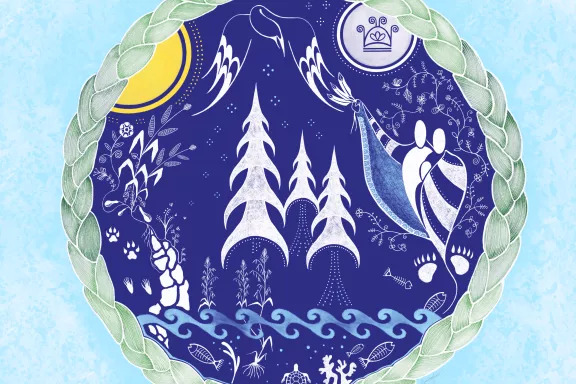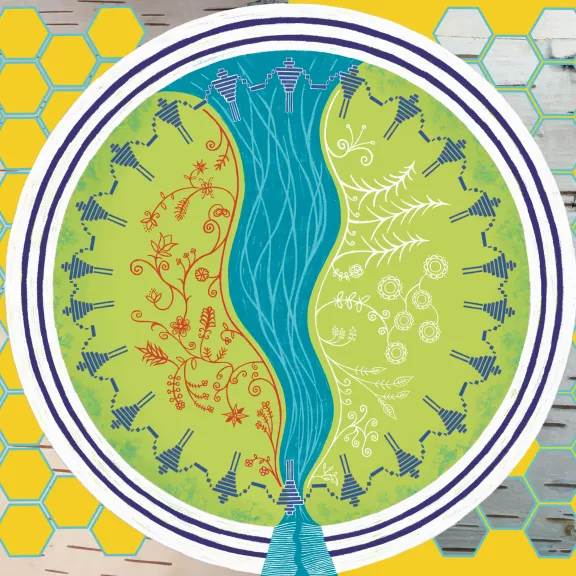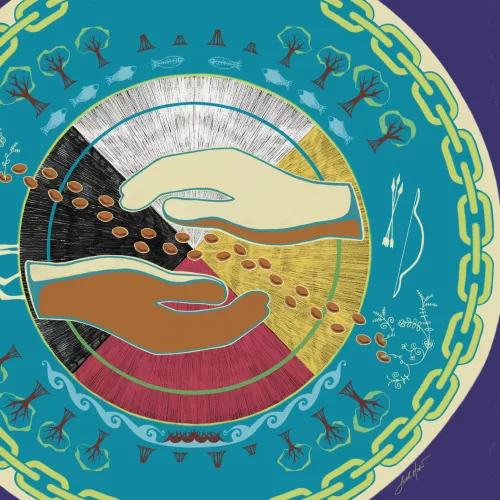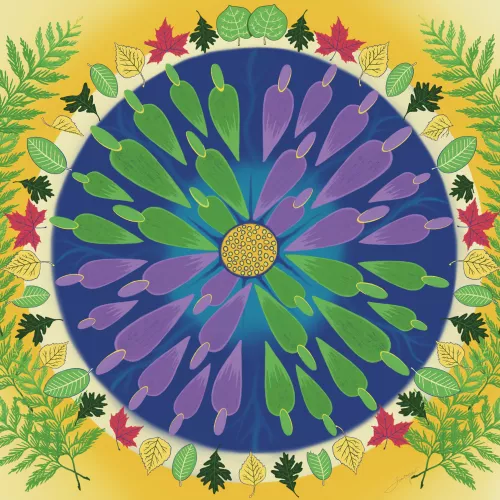

Written by Star Horn, Kanien'kehá:ka artist
The Two Row Wampum tells the story of one of the oldest treaty relationships between the Onkwehonweh (original people) of Turtle Island (North America) and European immigrants. The treaty was made in 1613 be-tween the Dutch and the Haudenosaunee (Iroquois) as Dutch traders and settlers moved up the Hudson River into Kanien’kehá:ka (Mohawk) territory. The agreement is founded upon the respectful co-existence of two different nations. Wampum belts are made of purple and white quahog shells to commemorate such agree-ments. Laid out in a circular fashion, the Two Row is the main focus of this piece.
Two purple rows on a white background symbolize two paths or two vessels, travelling down the same river together. One vessel, a birchbark canoe, represents the Indigenous people, their laws, their customs, and their ways. The other, a ship, symbolizes white settlers and their laws, their customs, and their ways. Each travel the river together, side by side, yet independently in their own vessel. Neither will make compulsory laws nor interfere in the internal affairs of the other. Most importantly, neither will try to steer the other’s vessel.
While the Two Row Wampum was created to commem-orate the introduction of the Dutch to the continent and is derived from Haudenosaunee traditions and philosophy, it is also consistent with the outlooks of many other Indigenous peoples seeking to accommo-date themselves to the sudden arrival of Europeans on Turtle Island. Almost universally, Indigenous peoples extended their hands in peace and friendship to the settlers on their lands and sought to improve their lives through trade and exchange with the newcomers. But at the same time, Indigenous peoples were intent on maintaining their own ways of life. This sentiment remains to this very day.
Humans connected
In a circular fashion, people join together creating a chain of strength, unity and cooperation. They are drawn in the style of the famous George Washington Belt where the figures are holding hands signifying peace between two nations.
Natural Elements
Each side of the water has Mother Earth’s bounty (more often referred to as ‘resources’ by non-indigenous people). The red plants are significant to Indigenous people, while the white plants are significant to non-In-digenous people. Both are shared, all are connected – animal and plant life depend on each other for survival as part of a natural system – and should not be overused.
Water
Water, the life-giver and sustainer of all life, is front and center in the piece to show its importance.
Honeycomb design
The honeycomb on either side of the piece symbol-izes the interconnectedness and importance of our relationship with the natural world. The bee is the per-fect example of how reliant we are on one of nature’s smallest creatures. Three out of four crops across the globe producing fruits or seeds for human use as food depend, at least in part, on pollinators. There are some 20,000 species of wild bees that pollinate plants, but it may come as a surprise to know that moths, flies, wasps, beetles and butterflies – as well as some ani-mals – pollinate plants.
Birchbark
The photo collage of the birchbark serves as a natural element adds a natural element and texture to juxtapose the cleaner geometrical design of the honeycomb.
Nia:wen

